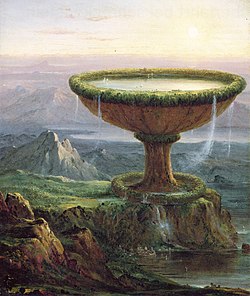
Back الكأس الكبير (لوحة) Arabic Xwey ke gulik (trutca ke Thomas Cole) AVK Чашата на титана Bulgarian Le Gobelet de Titan French Il calice del Titano Italian ദി ടൈറ്റൻസ് ഗോബ്ലറ്റ് Malayalam Kielich Tytana Polish The Titan's Goblet Turkish
| The Titan's Goblet | |
|---|---|
 | |
| Artist | Thomas Cole |
| Year | 1833 |
| Medium | Oil on canvas |
| Dimensions | 49.2 cm × 41 cm (19+3⁄8 in × 16+1⁄8 in) |
| Location | Metropolitan Museum of Art, New York |
| Accession | 04.29.2 |


The Titan's Goblet is an oil painting by the English-born American landscape artist Thomas Cole. Painted in 1833, it is perhaps the most enigmatic of Cole's allegorical or imaginary landscape scenes. It is a work that "defies full explanation", according to the Metropolitan Museum of Art.[2]
The Titan's Goblet has been called a "picture within a picture" and a "landscape within a landscape": the goblet stands on conventional terrain, but its inhabitants live along its rim in a world all their own.
Vegetation covers the entire brim, broken only by two tiny buildings, a Greek temple and an Italian palace. The vast waters are dotted with sailing vessels. Where the water spills upon the ground below, grass and a more rudimentary civilization spring up.
- ^ "Yggdrasil: The Sacred Ash Tree of Norse Mythology". The Public Domain Review.
- ^ The Titan's Goblet. Collections Database, Metropolitan Museum of Art. Accessed August 14, 2010.
© MMXXIII Rich X Search. We shall prevail. All rights reserved. Rich X Search